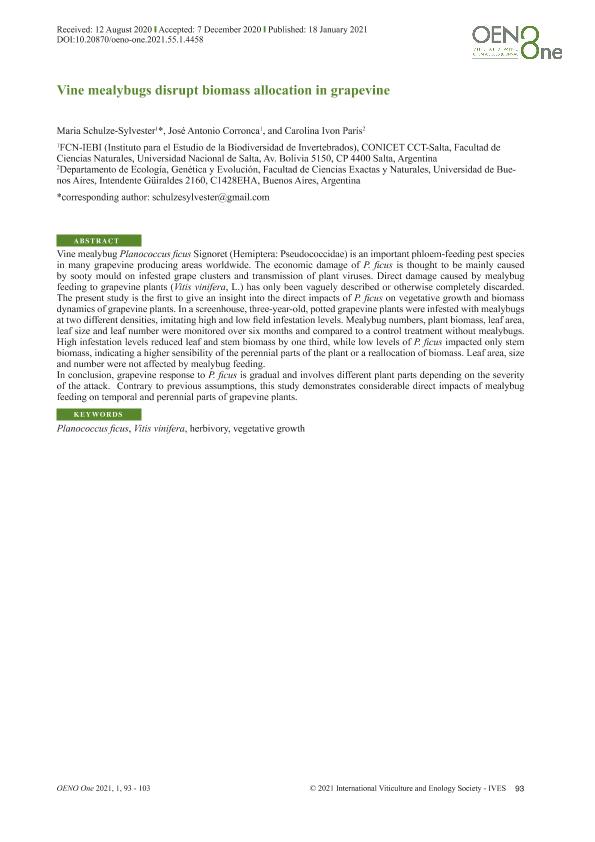Artículo
Vine mealybugs disrupt biomass allocation in grapevine
Fecha de publicación:
18/01/2021
Editorial:
Vigne et Vin Publications Internationales
Revista:
Oeno One
ISSN:
2494-1271
Idioma:
Inglés
Tipo de recurso:
Artículo publicado
Clasificación temática:
Resumen
Vine mealybug Planococcus ficus Signoret (Hemiptera: Pseudococcidae) is an important phloem-feeding pest species in many grapevine producing areas worldwide. The economic damage of P. ficus is thought to be mainly caused by sooty mould on infested grape clusters and transmission of plant viruses. Direct damage caused by mealybug feeding to grapevine plants (Vitis vinifera, L.) has only been vaguely described or otherwise completely discarded. The present study is the first to give an insight into the direct impacts of P. ficus on vegetative growth and biomass dynamics of grapevine plants. In a screenhouse, three-year-old, potted grapevine plants were infested with mealybugs at two different densities, imitating high and low field infestation levels. Mealybug numbers, plant biomass, leaf area, leaf size and leaf number were monitored over six months and compared to a control treatment without mealybugs. High infestation levels reduced leaf and stem biomass by one third, while low levels of P. ficus impacted only stem biomass, indicating a higher sensibility of the perennial parts of the plant or a reallocation of biomass. Leaf area, size and number were not affected by mealybug feeding. In conclusion, grapevine response to P. ficus is gradual and involves different plant parts depending on the severity of the attack. Contrary to previous assumptions, this study demonstrates considerable direct impacts of mealybug feeding on temporal and perennial parts of grapevine plants.
Palabras clave:
HERBIVORY
,
PLANOCOCCUS FICUS
,
VEGETATIVE GROWTH
,
VITIS VINIFERA
Archivos asociados
Licencia
Identificadores
Colecciones
Articulos(CCT - SALTA-JUJUY)
Articulos de CTRO.CIENTIFICO TECNOL.CONICET - SALTA-JUJUY
Articulos de CTRO.CIENTIFICO TECNOL.CONICET - SALTA-JUJUY
Citación
Schulze sylvester, Maria; Corronca, Jose Antonio; Paris, Carolina Ivon; Vine mealybugs disrupt biomass allocation in grapevine; Vigne et Vin Publications Internationales; Oeno One; 55; 1; 18-1-2021; 93-103
Compartir
Altmétricas




